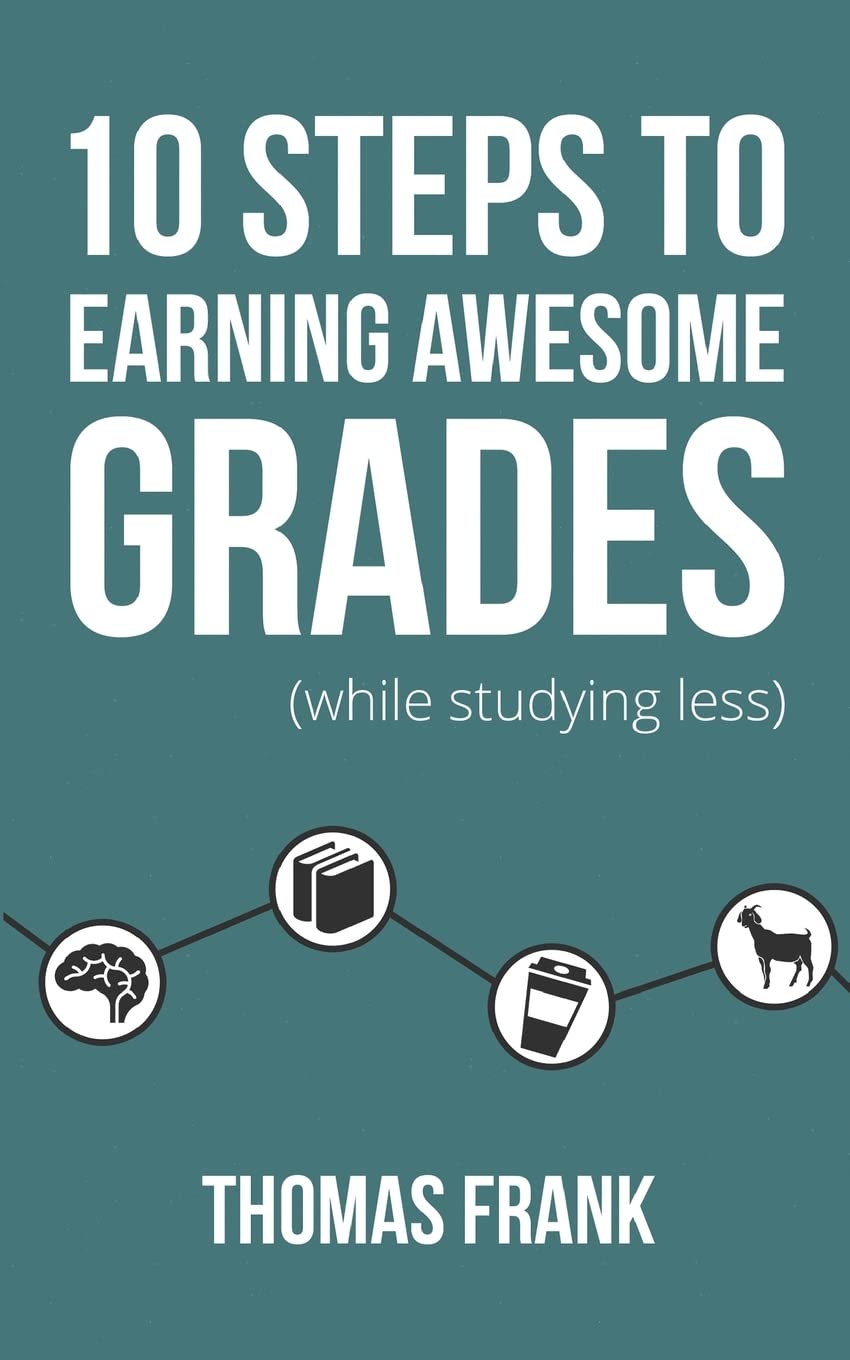A brief, pragmatic guide for scholars on enhancing productivity and studying more efficiently by experienced student-success author, Thomas Frank of College Info Geek.

- STEP 1 – BE MORE ATTENTIVE IN CLASS
- STEP 2 – MAKE MORE EFFECTIVE NOTES
- STEP 3 – EXTRACT MORE FROM YOUR TEXTBOOKS
- STEP 4 – STRATEGIZE LIKE A COMMANDER
- STEP 5 – CREATE A SUPERIOR STUDY ENVIRONMENT
- STEP 6 – COMBAT DISORDER AND MAINTAIN STRUCTURE
- STEP 7 – OVERCOME PROCRASTINATION
- STEP 8 – STUDY STRATEGICALLY
- STEP 9 – ENHANCE YOUR ESSAY WRITING SKILLS
- STEP 10 – ENHANCE GROUP PROJECTS LESS DULL
STEP 1 – BE MORE ATTENTIVE IN CLASS
Avert exhaustion by maintaining good health:
- Eat nutritious meals 90% of the time.
- Engage in regular exercise.
- Ensure a minimum of 6 hours of sleep every night.
Participate with intent and act consciously in class:
- Occupy a seat at the front.
- Contribute to class discussions.
- Take copious notes.
Take ample notes by discovering methods to compel yourself to do so:
- Make an internal commitment.
- Establish a note-sharing study group.
- Utilize a habit-tracking tool (like Habitica).
- Publicize your notes.
Reduce willpower-depleting hindrances by preparing in advance:
- Achieve next year’s lodging arrangements 7 – 8 months beforehand.
- Organize for the next day the previous evening (charge devices, pack bags, synchronize files).
- Employ notes (physical and digital) and alarms to prompt your attentiveness.
Be solution-focused but utilize the Professor’s office hours if you are genuinely stuck:
- Initially, challenge yourself for 15 minutes to solve a problem.
- Throughout that time, document all your attempts to resolve the issue.
- Only then, if you are still stuck, should you seek help.
- But not before having a clear response to the query:
“What is it [precisely] that I don’t comprehend?”
STEP 2 – MAKE MORE EFFECTIVE NOTES
Transcribing word for word will divert you from dedicating time to comprehending the content.
Instead, concentrate more on the essence than the expression when taking notes
Explore the following 5 note-taking techniques to assist:
- The Outline Method– a conventional hierarchical approach.
- Utilize bullets and sub-bullets to organize your notes
- Advantages: simple to implement.
- Disadvantages: can lead to thoughtless note-taking (see above).
- The Cornell Method– divide each page into three columns:
- Cue column– Questions derived from the main ideas and vital details.
- Note-taking column– Contains your regular notes during class.
- Summary column– End of class summary of your notes column.
- Advantages: organizes notes for efficient studying as you take them.
- The Mind Map Method (a superb web app is Coggle)
- Pen down a singular “umbrella term” in the middle of a blank page.
- Write words surrounding it that elaborate on the idea and additional words around those.
- Employ lines, colors, doodles, and diagrams to link all the words.
- The Flow Method– a holistic approach that compels active note-taking and is best used for subjects where ideas naturally connect.
- Jot down important terms as they arise.
- Connect them with arrows to display connections.
- Synthesize things in your own words (avoid repetition).
- Create backlinks to earlier sections of your notes
- The “Write on Slides” Method– annotate your slides instead of jotting separate notes (ensure to remain engaged and don’t become sluggish!).
STEP 3 – EXTRACT MORE FROM YOUR TEXTBOOKS
Refuse to cover all your designated reading.
- Many topics will be addressed in class; and
- You won’t be examined on a considerable portion.
Instead, assess your classes and partition your reading into:
- Primary readings– materials you must peruse (such as the generally obligatory textbook); and
- Secondary readings– materials it would be beneficial to read (compact books, articles, case studies etc…).
Adjust your reading approach to the method your knowledge will be assessed e.g.,
- Multiple Choice– Master facts and precise details; or
- Essays– Detect and summarize the principal ideas.
Read actively, not passively utilizing these 6 strategies:
- Pseudo-skim– Quickly move through filler text, slow down for the crucial content.
- Read the chapter backward– Initiate your brain with any summary points, glossaries, and questions.
- Create questions– While reading, rephrase the details into questions you can utilize to quiz yourself later.
- Pay attention to formatting– e.g., bold, italics, and lists
- Mark up and take notes in your book– Employ sticky flags if you cannot deface the book, alternatively use a pencil or highlighter.
Write synopses of what you read as if you were instructing it to others.
- Summarize what you’ve just read from memory promptly after completion (active recall).
- Simplify it and evaluate your understanding by envisioning teaching it to someone else.
STEP 4 – STRATEGIZE LIKE A COMMANDER
Distinguish planning from executing.
This will enable you to concentrate on carrying out tasks without hesitation rendering you more efficient.
Devise and revise a long-term plan for your education from the beginning.
Schedule your week on a Sunday and align your tasks with your vitality levels:
- Compile a list of academic and non-academic obligations for the week.
- Categorize those activities by “High” and “Low” cognitive-intensity work.
- Organize and adjust your tasks throughout the week based on your energy levels.
- Familiarize yourself with your typical peak energy times and adapt accordingly.
Plan your day the prior evening or first thing in the morning:
- Review your schedule and task lists.
- Create a list of tasks that need to be accomplished the next day.
- Prioritize your list by placing the most crucial activities at the top depending on:
- Positive impact– What will propel you closest to your objectives?
- Negative impact– What will prevent your life from descending into chaos?
- Willpower– What will demand the most willpower to finish?
- Estimate the duration required for each task (adjust for your fudge ratio*)
- Combine this with your starting time to establish a target end for the day.
- Commence from the top of the list and progress down.
* To determine your fudge ratio (the amount you tend to underestimate timings):
- Estimate your task durations for the day (e.g., task A: 1 hour).
- Record your actual times (e.g., task A: 1h 37 mins).
- Divide your actual times by your estimations (97 mins / 60 mins = x1.62).
- Utilize your fudge ratio to refine your estimates.
- Rely on your intuition once you have a better grasp on setting durations.
Deconstruct projects by:
- Segmenting the project into tasks.
- Grouping the tasks into contexts.
- Determining exactly how and when you will allocate resources to them.
STEP 5 – CREATE A SUPERIOR STUDY ENVIRONMENT
Intentionally craft your surroundings to reduce obstacles.
- Enhance your location and background music.
- Decrease physical and technological diversions.
Regarding location:
- Operate in spaces where other individuals are also engaged (e.g., libraries, coffee shops, and collaborative areas).
- Explore unconventional options (e.g., participate in intensive workshops or dedicate weekends to a specific subject).
For music: experiment to determine what is most effective for you…
- Sample various music genres for different tasks.
- Test white, pink, or brown noise.
- Try ambient sounds (e.g., rain, coffee shop ambiance, etc.).
- Combine them for a unique blend.
To minimize real-world disturbances:
- Avoid disruptive environments – As mentioned earlier, this is a matter of personal preference.
- Avoid distracting individuals – Collaborating with friends may not always be beneficial.
- Learn to decline to engage in enjoyable activities.
- Make it challenging for others to reach out to you (refer to above and below).
To reduce digital diversions: establish barriers that make procrastination more troublesome than productive:
- For your mobile device:
- Power it down.
- Disable most notifications.
- Enable the “do not disturb” mode.
- For your computer:
- Utilize applications like StayFocusd (Chrome), FocalFilter (Windows), ColdTurkey (Windows), or SelfControl (Mac) to block access to time-consuming websites.
- Uninstall time-consuming applications (e.g., games).
- Hide the bookmarks toolbar in your browser.
- Create a separate user profile on your computer for work-related activities.
- Utilize a different computer altogether (e.g., in a computer laboratory) to complete your tasks.
STEP 6 – COMBAT DISORDER AND MAINTAIN STRUCTURE
Arrange your files effectively:
- Install and set up Dropbox/Google Drive – allowing access to your files from anywhere.
- Establish an organized folder system – organize your life into logical sections initially.
- Create your university folder – categorize it by year > class > assignments, and include additional sections for clubs.
Establish a swift method for capturing ideas using tools such as a physical notebook or applications like Drafts (iOS), Evernote, Scanbot, Trello, Google Calendar, Todoist, or Pinboard.
Employ Evernote (or Dropbox) as a secondary resource.
Use a task management tool: “Select a task manager that aligns with your preferences.”
Some viable options include: Wunderlist, Remember the Milk, Google Tasks, Todoist, Producteev, Omnifocus, and Asana.
Combat disorder and resistance by utilizing a checklist to maintain organization within your life and systems each week.
STEP 7 – OVERCOME PROCRASTINATION
Refuse to succumb to procrastination by adding “but I am going to do it anyways” after saying, “I don’t feel like it.”
The Procrastination Equation is a valuable way to approach motivation. It suggests:
- Motivation= (Expectancy x Value) / (Impulsiveness x Delay) where
- Expectancy– your perceived likelihood of succeeding in the task;
- Value– how much the reward means to you;
- Impulsiveness– your susceptibility to distractions; and
- Delay– the time required to obtain the reward.
To boost motivation:
- Acknowledge when you are procrastinating.
- Identify the aspect of the equation that is lacking.
- Resolve the issue. For instance,
- Enhance expectancy – refine your confidence in accomplishing the task;
- Enhance the task’s value – amplify the reward or make the process more gratifying;
- Minimize impulsiveness – better evade distractions (reference tip 5); and
- Embrace delay – reward yourself with small treats (e.g., chocolate).
Cultivate positive habits with Habitica
- Your willpower has limits.
- Habits enable you to act without exerting willpower.
- Constructing beneficial habits simplifies daily commitment.
- Habitica facilitates habit-building by rendering it enjoyable and communal.
Grant yourself the flexibility to consolidate enjoyable activities (e.g., games, social media) into concentrated intervals that motivate you to complete your tasks.
Adopt the Pomodoro technique to concentrate solely on the forthcoming 25 minutes:
- Commit to a single task.
- Set a 25-minute timer.
- Utilize the time efficiently.
- Take a brief 3 – 5‑minute break.
Make procrastination (failing) unpleasant using tools like Beeminder
STEP 8 – STUDY STRATEGICALLY
Prepare for assessments by simulating test conditions during your study sessions. To do this:
- Collect your materials – syllabus, handouts, notes, assignments, textbooks.
- Identify the likely test topics – prioritize these in your study plan.
- Create study aids for each topic – devise questions that test your recall on the subject.
- Engage in studying – draft responses to the questions.
- Quiz yourself – practice until answering those questions under test conditions is effortless.
Prioritize active learning over passive learning.
- Passive learning – exposing yourself to material and hoping for absorption.
- Active learning – challenging yourself to recollect information independently through testing.
Utilize spaced repetition (see Anki) to enhance learning effectiveness.
- Encourages recall specifically when retention is likely to falter.
- Focuses on reinforcing knowledge in areas where improvement is required.
For disciplines like Mathematics:
- Recognize confusion patterns – pinpoint uncertainties (refer to step 1), and address gaps by working on problem sets.
- Comprehend, not memorize – persistently dissect concepts until reaching moments of clarity, and assess understanding by explaining concepts to others.
- Embrace the practice – Master concepts by solving numerous problems.
STEP 9 – ENHANCE YOUR ESSAY WRITING SKILLS
- Conduct an unstructured brainstorming session – Compile knowledge, questions, key points, sources, and quotes.
- Develop a focus and formulate questions to address – Break down your research and provide it with direction.
- Maintain a systematic and focused research approach
- Source materials – Reference Wikipedia, textbooks, and Google Scholar for research outlets.
- Create a personal archive – Save or scan content to platforms like Evernote or Dropbox.
- Annotate the sources – Summarize readings with notes linking back to specific page references.
- Decide on completion – Conclude once you have at least two supporting facts for each main point.
- Write a rough initial draft – Transfer your ideas onto paper without reservations, preferably in a separate document or application like Evernote or Byword (Mac, iOS).
- Thoroughly edit – Supplement necessary details, rearrange content, rectify errors by evaluating:
- Is there a cohesive narrative flow?
- Are the primary ideas clear, pertinent, and effectively delivered?
- Do the sections substantiate the central theme?
- Is there enough research to validate the facts provided?
- Could I eliminate or express it differently?
- Enhance the writing– Verify spelling, grammar, layout, tempo, and continuity by:
- Print the paper and identify the mistakes manually.
- Read the paper vocally to yourself.
- Observe your frequent mistakes (e.g., spelling, punctuation).
- Request feedback from professionals and non-professionals.
- Select each potential evaluator once only.
- Specify the type of feedback (elaborate, overall view) you need.
- Perform a final inspection– Question yourself “Is it prepared?” When you are content, release it.
STEP 10 – ENHANCE GROUP PROJECTS LESS DULL
Utilize the initial gathering effectively:
- Familiarize all group members
- Engage in casual conversation and exhibit general amiability.
- Collect names, phone numbers, emails – distribute these to the whole team during the meeting.
- Encourage everyone to share insights about themselves (strengths, weaknesses, preferences, aversions).
- Establish targets and anticipations – “When unsure, lead the way.”
- Formulate and arrange checkpoints for the project.
- Assign each duty to a particular individual based on capabilities and inclinations (never presume a task will be completed).
- Schedule the subsequent meeting.
- Construct robust communication pathways– explore Slack
Designate an editor whose responsibility is to compile and integrate all completed segments.
Employ exceptional tools to streamline tasks:
- Trello– For monitoring and assigning tasks.
- Slack– For team interaction.
- Google Docs– For concurrent document collaboration.
FINALE – WHAT TO DO NEXT
- Select 1 – 2 key focal points.
- Document a target for that realm.
- Create a plan of action to accomplish it.
- Commence!


